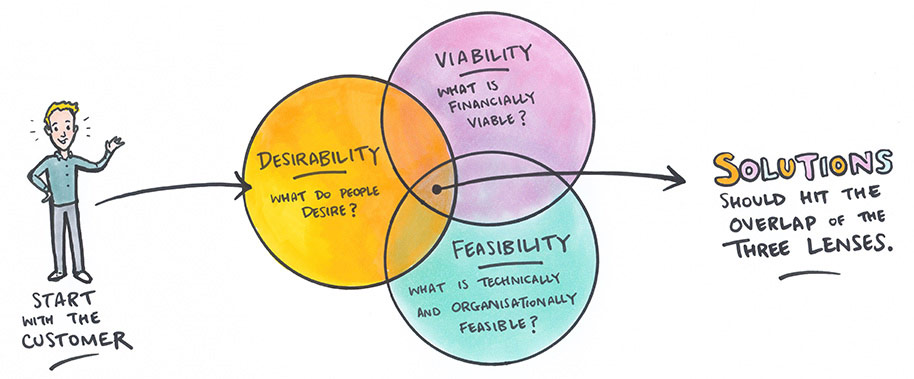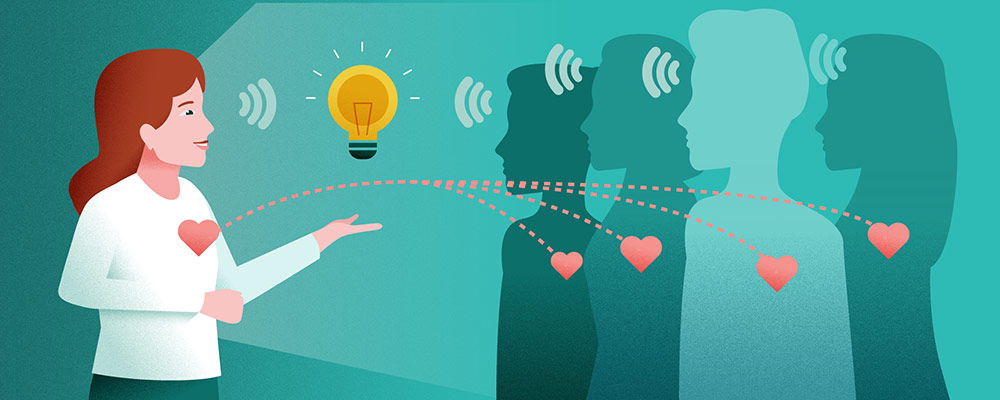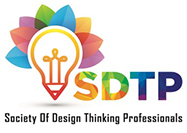As Julie Zhuo quoted, “If you’re interested in design, the best thing is to observe how people interact with each other and the things they use.” The process of Design Thinking cannot get a kick start without understanding people and the problems they might be facing. The first step of Design Thinking is Empathy, the psychological component, without which it is challenging to understand your users.
d.School Bootcamp Bootleg in 2013 stated, “Direct interaction with people reveals a lot about how they think and what values they have. These beliefs and values are not always clear to those who hold them. Deep participation can surprise both the designer and the designee with unexpected ideas that depart from what they normally do – and are strong signs of their strongly held opinions about the world.”
What Is Empathy?

Empathy is the ability to decipher the world through different perspectives, through the eyes of the users, feel what they feel, see what they see, and experience things the same way they do. Of course, it is impossible for any of us to walk the same roads and the same miles as others, but we may try to get as close as possible by setting aside our own life experiences or assumptions and focusing on understanding the ideas, thoughts, and needs of others.
Empathy in Design Thinking is defined as a “deep grasp of the challenges and reality of the people you are designing for,” according to IDEO’s Human-Centered Design Toolkit. It entails learning about people’s problems as well as revealing their hidden wants and needs to understand their actions. To accomplish so, we must first comprehend the people’s surroundings, as well as their responsibilities and roles in it.
The best part of Empathy is that it is not like any other market research, to only look at the facts and figures, but an in-depth analysis on their thoughts and motivations, and the driving force to keep them going. It’s fundamentally subjective, because figuring out what people mean rather than what they say requires a good degree of interpretation. It is the process of appreciating and understanding the physical and emotional needs of the users.
Why Is Empathy Important?

The importance of a human-centric design approach is at the root of design thinking. The success of the company will be ensured if designers are guided from a user’s standpoint to acquire insights into their needs. There are three criteria by which we can evaluate a design’s success.
- Desirability
- Viability
- Feasibility
It is critical for users to feel a sense of desirability to find a solution. When people’s wants, experiences, needs, and preferences are adequately recognised, it is easier to fully comprehend and build a desirable product or service.
If there is a balance in desirability, feasibility, and viability, then there is a much higher chance of increasing the value of the design’s end result. A perfect way to perform empathy in any project is to ask questions:
Desirability
- Will the solution fit in the user’s life?
This question opens the door for the probability of finding ways the solution may support or conflict with the user’s lifestyle. - Will the solution suit the user?
Well, it may not be the only consideration, but looking into the appeal factor can be helpful. - Will the solution fulfil the needs of the user?
It is great to start with doing a double-check on the fact that the solution you are providing is adding value to different lives or not. - Will the user want the solution?
It is best to look into the needs of the user, before going through the entire process of designing and executing the project. It won’t be of any use if the user doesn’t want it.
Feasibility
- How long will it take?
You need to have a feasible solution and not one that does not fit the timeline of your user. - Is the technology required to power the design solution readily available or accessible?
The goal is sometimes to develop new technology, but other times we must work with what we have. Early on, decide what your goal is in this area.
Viability
- Does a design solution match the business goals?
When it is clear what a user wants to accomplish, it is easier to focus the energy in that direction. - Does the solution take care of the user’s budget?
You have to find a solution in a given budget because a solution is not considered viable if it exceeds the user’s budget. - What will ROI look like to the user?
It’s useful to compare the time and effort required to implement a solution to the potential payout in terms of desired objectives—whether monetary or other quantitative outputs. It may be worth focusing on a new solution if the investment considerably surpasses the advantages.
There is a lower possibility of success if you don’t know whether the product or service is appealing to the target demographic. If the items and services aren’t desirable to the customer, a company can’t generate a profit on its own. It’s only natural to take an empathic approach to design. It is one of the most important elements in a business’s development and can assist in the resolution of issues that you didn’t know existed.
How To Empathize?

Making empathy a part of your daily life—or, to put it another way, flexing and developing your empathy muscle—can help you become more consciously aware of the people around you. Make an effort to pay attention to others around you and empathize with their feelings. When it comes to your next design project, the more empathy you develop in the outside world, the easier it will be to put yourself in your user’s shoes.
Facial Expressions
Research is proof that if we copy the facial expressions of others, we can get the way they are feeling in the moment. Empathic activities, such as replicating someone’s facial expressions, cause considerably more activity in the emotion centers of the brain than simply viewing similar facial emotions, according to UCLA researchers. When we watch someone stub their toe, for example, we may find ourselves wincing almost reflexively. Empathize with the users by emulating their facial expressions during chats or while observing them.
Listen Without Judging
We have assumptions about almost every situation, and it may hinder your ability to empathize. We all have our preconceptions, misconceptions, and experiences to offer while being in a situation, and this helps us to make sense of the world around us. But, the time we perform empathy, we have to set them aside, to actually listen to and engage with people effectively.
Consider it a mental reset; adopt a “blank” mindset, devoid of any preconceived notions or prejudices. If you really pay attention to what other people are saying, you’ll learn a lot about how they think as a person.
Body Language
From the tiniest of postures to the way a person is standing or folding his arms, speaks so much about the person. It is important to follow the lead of these physical signs to be more empathetic towards the users.
It’s critical to discern between what individuals say they’d do in a given situation and what they actually do as a designer. In actuality, users may have unspoken habits or desires, thus it’s critical for the designer to see the user in action.
What Are The Ways To Build Empathy Virtually?

When you deep dive into the empathy phase, you have to both observe and engage with your users for successful results. There are many techniques to build empathy to identify the pain points of your users and find proper solutions for them.
Here is what could be done to build empathy,
Interviews
Conducting empathy interviews is one approach to develop empathy. The secret to a successful empathy interview is to arrange it as an open discussion rather than a scripted series of questions. Keep in mind that the purpose is to gain as much knowledge as possible, not to support or refute a predetermined view.
The best way to conduct empathy interviews is to keep the question “why?” top on the list along with promoting storytelling and paying attention to nonverbal indicators. When conducting an empathy interview, one of the most crucial things to remember is to be present and attentive.
You can conduct the interview with a team of three people, one can ask the questions, the second one can take the notes, and the third one can be an observer.
You can conduct empathy interviews virtually also, looking at the present pandemic scenario. Here are a few things to follow to make an interview possible virtually.
- Create a Google Form or a questionnaire with the questions you would like to ask.
- You can conduct a telephonic interview.
- You can go for a video interview via Zoom or Google Meet.
The purpose of an empathy interview is to truly understand the experience, need, and desires of the individual for whom you are designing, which is why it is necessary to do one.
Immerse And Observe
Body language refers to the subtle, non-verbal signs that we pick up – often subconsciously – and that are crucial for understanding not only the meaning of words, but also what’s going on in a meeting. Body language, for example, is frequently used to indicate optimism or pessimism. Body language is also an important technique of synthesising information and determining the level of engagement in a meeting.
The purpose of an empathy interview is to truly understand the experience, need, and desires of the individual for whom you are designing, which is why it is necessary to do one. Though it is thought that reading body language in the virtual world is difficult, the impact of virtual or in-person meetings on recording non-verbal behaviours is low. A keen eye for nonverbal cues can be extremely beneficial. It may appear complicated, but it is actually rather simple.
What to do:
- Maintain good eye contact – you’re probably wondering how to do this when the interview is virtual. When speaking, look at the camera rather than the person or respondent, and shift your gaze rapidly when the respondent is responding. When someone makes eye contact with you, it should indicate that they are eager to answer.
- Make sure you’re completely focused on the interview and in active listening mode, rather than multitasking.
- You can also use phrases like “I understand how you feel” or “Yes, I understand” while speaking.
- At this moment, refrain from offering any advice; your role is to listen.
Extreme Users
Extreme consumers are frequently used by designers in their quest to establish empathy and genuinely comprehend the challenge that their users experience. “The needs of extreme users are slightly exacerbated. They require/desire less or more of something in order to solve their issues. In contrast to regular consumers, they frequently develop work-arounds to existing difficulties.”
Engaging with extreme users might assist you in identifying issues and wants those so-called mainstream users may find difficult to express. You’ll be far more positioned to come up with unique solutions if you develop empathy for both the “averages” and “extremes” of your intended customer group.
Empathy Maps
It is another amazing tool to know your users better. An empathy map, according to the Nielsen Norman Group, is “a collaborative graphic used to express what we know about a specific sort of user.” It externalizes user knowledge to
- build a shared understanding of user demands and
- help with decision-making.”
The empathy map revolves around the four quadrants when it comes to knowing your users better.
- Says: It includes the direct words used by the user during an empathy interview.
- Thinks: It takes into consideration the thinking of the user at the time of the interview.
- Does: It captures the user’s actions and the way he deals with the situation in front of him.
- Feels: It considers the emotions the user might experience during his interview session.
What, Why, And How?
During the empathy phase, you should be thinking about the what, why, and how of your users’ actions. The what-why-how framework can assist you in converting your (non-assumptive) findings into more ideal user motivations. Divide your page into three areas and write down what you’ve seen in the following order:
- What: Refers to the specifics of what happened: for example, when inputting payment information on an e-commerce website, the user took the following steps.
- Why: If the user completed the task successfully, then this segment looks for the motivation to do so.
- How: You’ll look at how the user fulfilled these tasks in this section. What were their expressions like? Were they putting forth a significant amount of effort? Did they seem confused, agitated, or at ease?
Empathy is vital for designers, especially design thinkers because it allows us to genuinely comprehend and unearth the hidden needs and feelings of the people for whom we are designing. As a result, we can create solutions that satisfy the three criteria that make a product or service successful: desirability, feasibility, and viability. This is referred to as “the Empathize stage” in Design Thinking. Empathy-driven design distinguishes The Embrace Warmer from other human-centered products like Google Glass. The good news is that we are all fundamentally empathic, therefore anyone can learn to master empathy and become a brilliant designer thinker.
If you want to engage in the detailed process of Design Thinking, you can follow the links below:
https://www.amazon.in/Thinking-Playbook-Practitioners-Professionals-Publication/dp/1636333745/ref=sr_1_5?crid=1Z3X1ZYMG86J8&keywords=design+thinking+playbook&qid=1641439525&sprefix=design+thinking+playbook%2Caps%2C199&sr=8-5
https://notionpress.com/read/design-thinking-playbook-for-practitioners
https://www.interaction-design.org/literature/article/stage-1-in-the-design-thinking-process-empathise-with-your-users
https://careerfoundry.com/en/blog/ux-design/what-is-empathy-in-design-thinking/
Image Source:
https://www.lawboxdesign.com/wp-content/uploads/2020/08/design-thinking-5-Empathy-e1597244328334-1024×476.png
https://chiefexecutive.net/wp-content/uploads/2020/10/AdobeStock_302643137.jpg
https://ventures.pickles.com.au/wp-content/uploads/2019/03/Desirability_Feasibility_Viability.jpg
https://cdnblog.webkul.com/blog/wp-content/uploads/2019/09/Empathy-Map1.png
https://www.lollydaskal.com/wp-content/uploads/2018/04/Screen-Shot-2018-04-09-at-12.08.43-AM.png
https://www.duarte.com/wp-content/uploads/3-Ways-to-Better-Connect-with-Your-Virtual-Audiences.png
Written by: Jimmy Jain & Afreen Fatima
Society of Design Thinking Professionals









